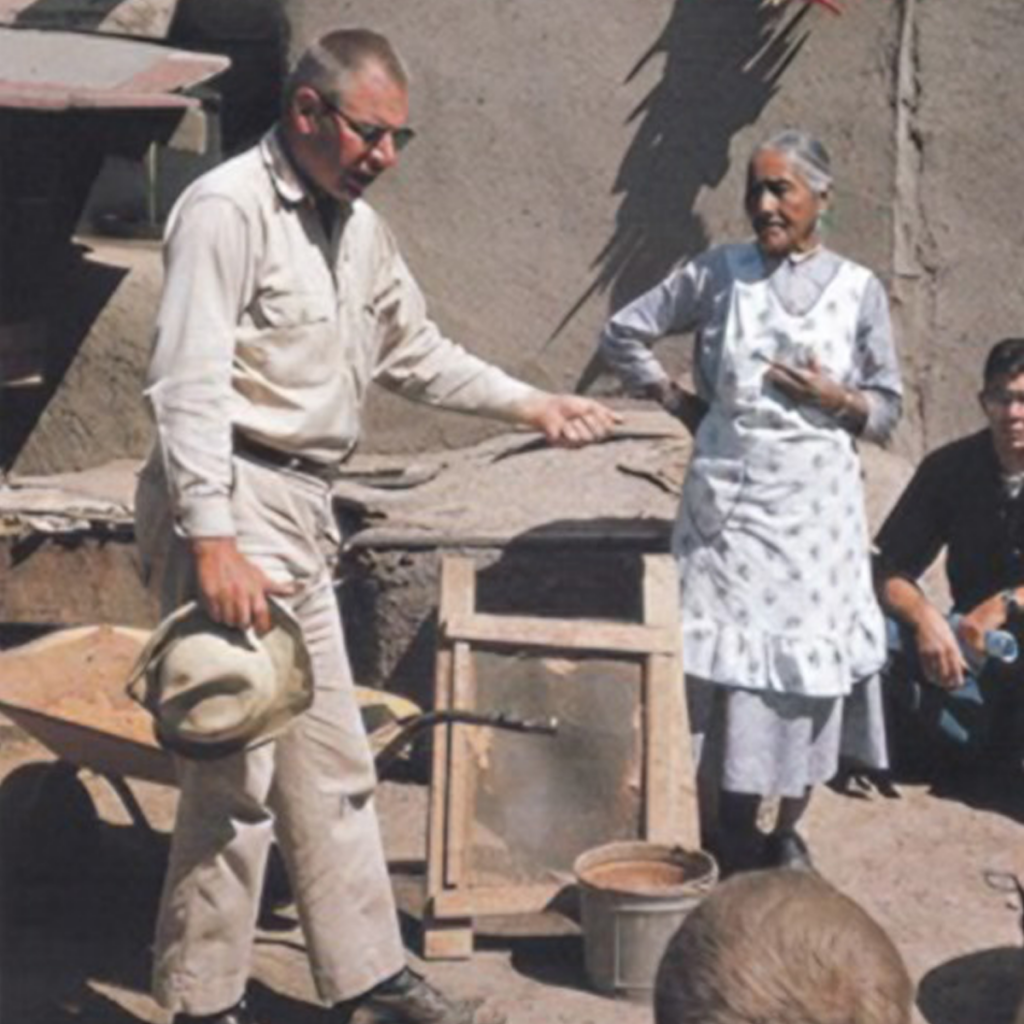Virginia Duran
1904 - 1998
Taos County
Learning from mothers and grandmothers in their community, these three women were instrumental in preserving the traditions of micaceous clay pottery making. While micaceous pottery has long been valued for cooking, these three women helped promote them as works of art.
Three Picuris women, Maria Ramita Simbola Martinez, Cora Durand, and Virginia Duran, helped to preserve the micaceous pottery tradition that remains important in Picuris and other nearby pueblos today. Picuris is a Tiwa speaking Pueblo located fifty-seven miles north of Santa Fe. According to archaeological excavations, Picuris had been occupied as early as AD 1100, and micaceous pottery from the community has been dated back to as early as 1600. Picuris and Taos, two pueblo communities located twenty miles apart, share numerous traditions, including micaceous pottery: Both communities use mica-rich clay from nearby mountains. Picuris clay reserves have been threatened by road construction and mining.
Maria Ramita Simbola Martinez, known as ”Summer Harvest,” was born in 1884 to Lorenzo and Solidad Simbola. She learned to make pottery by watching her mother and other potters in the community. She and her husband, Juan Jose Martinez, worked together—she formed the pots and he decorated them. He used a variety of tools to design the pots, including files, bolts, nails, screws, and silverware. The couple would travel by wagon to local communities to trade their wares, and eventually created pots to sell to tourists.
Virginia Duran was born in Picuris in 1904. She was one of Picuris’s more notable micaceous potters. In addition to using mica rich clay, Duran enhanced the glittery sheen of mica-rich clay by rubbing a mica slip on her pots before firing.
Cora Durand was born in 1904 to Miguelito and Crucita Lopez, both of Picuris. Cora married Roland Durand, also of Picuris, and had four children and numerous grandchildren. Cora learned to make micaceous pottery from her grandmother, and she passed this tradition on to her own grandson, Anthony Durand, now a well-known micaceous potter. She also taught pottery making to other women in her community. In 1995, she participated in the first Micaceous Pottery Market, along with her grandson.
Micaceous pots have traditionally been used for utilitarian purposes such as cooking. Because of the mica content of the clay, these pots retain heat and are waterproof. While designed specifically for cooking beans, micaceous bean pots can be used to cook a variety of foods. Oil can be used as a sealant to prevent food from taking on an “earthy” flavor. Some say these pots can be used over an open flame while others advise the use of a covered flame. Micaceous pots can also be used in the oven.
Unlike pottery from other Pueblos, micaceous pots are generally unpainted, but have a glittery sheen due to mica-rich clay. Some pots have decorative relief, such as clay beads, ribbons, and lizards, as well as incised patterns. Bean pots may have handles and lids. Some potters also shape micaceous clay into figurines, such as animals or nativity scenes.
Still valued for their utility, these pots are also now considered works of art. Although associated with Picuris, Taos, and the Jicarilla Apaches, individuals from other Pueblo communities are now working with micaceous clay and continue a tradition that Martinez, Duran, and Durand were instrumental in preserving.
Sources:
Anderson, Duane. All That Glitters: The Emergence of Native American Micaceous Art Pottery in Northern New Mexico. Santa Fe: School of American Research Press, 1999.
Barry, John W. American Indian Pottery: An Identification and Value Guide. 2d. Edition. Florence, AL.: Books Americana, 1984.
Sando, Joe S. Pueblo Profiles: Cultural Identity through Centuries of Change. Santa Fe: Clear Light Publishers, 1998.
Trimble, Stephen. Talking with the Clay: The Art of Pueblo Pottery. Santa Fe: School of American Research Press, 1987.
“A Brief History of 3 Women from Picuris Pueblo.” New Mexico Historic Women Marker Initiative archive, (unpublished biographical sketches by Picuris Pueblo, 2008).
Directions:
Virginia Duran
Taos County
Artist | Cultural preservationist | Educator |
Statehood (1912 - present) | Territorial Period (1848 - 1912) |
North Central







